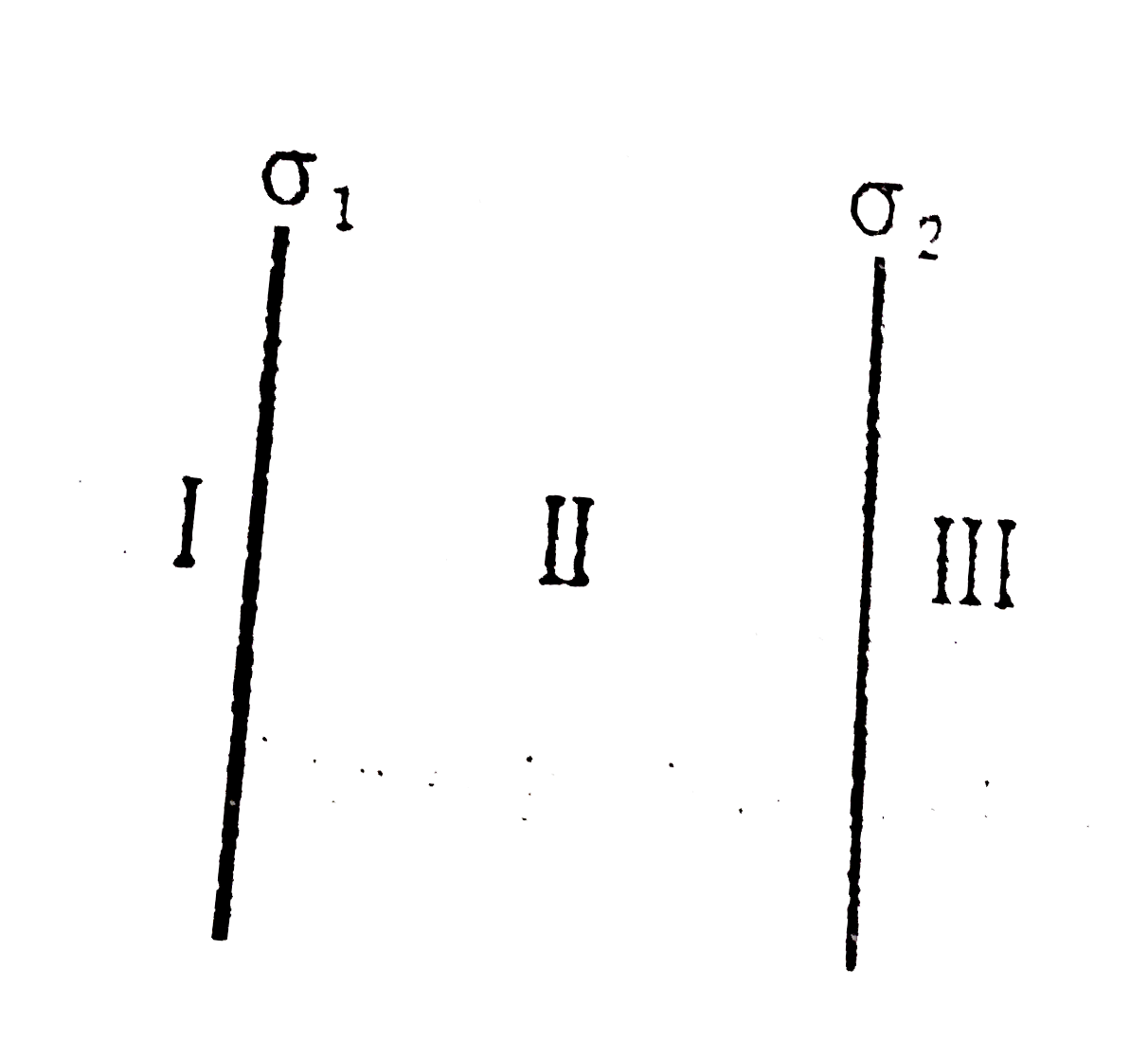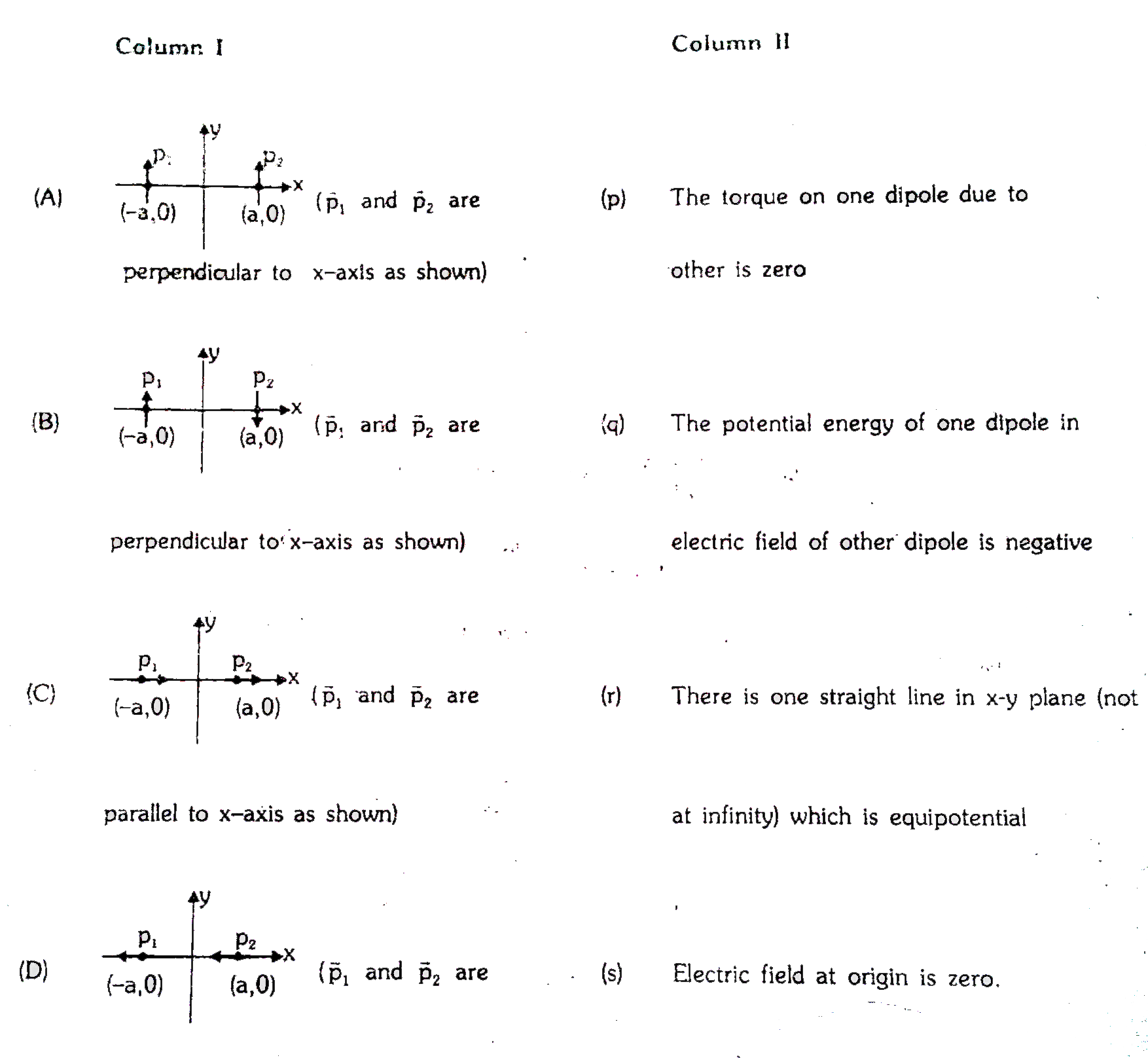Let are three unit vector such that os also a unit vector. If pairwise angles between are and respectively then equalsSolution in Gujrati
The correct Answer is:D
Topper's Solved these Questions
- MISCELLANEOUSBOOK - ALLEN CHAPTER - MISCELLANEOUSEXERCISE - Exercise-03
1 Videos
- MISCELLANEOUSBOOK - ALLEN CHAPTER - MISCELLANEOUSEXERCISE - Exercise-04
1 Videos
- MISCELLANEOUSBOOK - ALLEN CHAPTER - MISCELLANEOUSEXERCISE - Exersice -05(B)
20 Videos
- KINEMATICS (MOTION ALONG A STRAIGHT LINE AND MOTION IN A PLANE)BOOK - ALLEN CHAPTER - KINEMATICS (MOTION ALONG A STRAIGHT LINE AND MOTION IN A PLANE)EXERCISE - BEGINNER S BOX-7
8 Videos
- PHYSICAL WORLD, UNITS AND DIMENSIONS & ERRORS IN MEASUREMENT BOOK - ALLEN CHAPTER - PHYSICAL WORLD, UNITS AND DIMENSIONS & ERRORS IN MEASUREMENT EXERCISE - EXERCISE-IV
7 Videos
Similar Questions
Two parallel metallic plates have surface charge densities σ1 and σ2 as shown in figure.

Column-IColumn-II(A)If σ1+σ2=0(p)Electric field in region III is towards right(B)Ifσ1+σ2>0(q)Electric field in region I is zero(C)If σ1+σ2<0(r)Electric field in region I is towards roght(s)Nothing can be said
View SolutionIn each situation of Column-I two elelctric dipoles having moments →p1 and →p1 of same magnitude (that is ,p1=p2) are placed on x-axis symmetrically about origin in different orientations as shown. In column-II certain inferences are drawn for these two dipoles. Then match the different orientations of dipole in column-I with the corresponding result in column-II.

View SolutionPlanck's constant has dimensions …………….
View SolutionA football player kicks a ball at an angle of 30∘ with an initial speed of 20 m/s. Assuming that the ball travels in a vertical plane, calculate (a) the time at which the ball reaches the highest point (b) the maximum height reached (c) the horizontal range of the ball (d) the time for which the ball is in the air, (g=10m/s2)
View SolutionAssertion : Gravitational forces do not depend on the medium between the masses.
Reason : Mediating particle responsible for gravitational force is graviton.
View SolutionLet →a,→b , →c be three unit vectors such that ∣∣→a+→b+→c∣∣ and →a⊥→b. If →c makes angles α,β with →a,→b respectively then cosα+cosβ is equal to 32 (b) 1 (c) −1 (d) None of these
View SolutionLet vec a,vec b,vec c be three unit vectors such that |vec a+vec b+vec c|=1 and vec a is perpendicular to vec b. if vec c makes angle alpha and beta with vec a and vec b respectively,then cos alpha+cos beta=
View SolutionLet →a,→band→c are three vectors such that |→a|=3,∣∣→b∣∣=3,|→c|=2.∣∣→a+→b+→c∣∣=4and→a is perpendicular to →b,→c makes angle θandϕ with →aand→b respectively, then cosθ+cosϕ=
View SolutionvecP,vecQ,vecR,vecS are vector of equal magnitude. If vecP+vecQ-vecR=0 angle between vecP and vecQ is theta_(1) .If vecP+vecQ-vecS=0 angle between vecP and vecS is theta_(2) .The ratio of theta_(1) to theta_(2) is
View SolutionGiven that P=Q=R . If vec(P)+vec(Q)=vec(R) then the angle between vec(P) and vec(R) is theta_(1) . If vec(P)+vec(Q)+vec(R)=vec(0) then the angle between vec(P) and vec(R) is theta_(2) . The relation between theta_(1) and theta_(2) is :-
View SolutionIf →a,→b,→c are unit vectors such that →a is perpendicular to the plane of →b,→c, and the angle between →band→c is π3
Then, what is ∣∣→a+→b+→c∣∣?
View SolutionIf the line −−→OR makes angles θ1,θ2,θ3 with the planes XOY,YOZ,ZOX respectively , then cos2θ1+cos2θ2+cos2θ3 is equal to
View SolutionIf →a,→b,→c be three vector of magnitude √3,1,2, such that →a×(→a×→c)+3→b=→0, if θ is the angle between , then cosθ is equal to :
View Solution→P,→Q,→R,→S are vector of equal magnitude. If →P+→Q−→R=0 angle between →P and →Q is θ1 . If →P+→Q−→S=0 angle between →P and →S is θ2 . The ratio of θ1 to θ2 is
View Solutionvec(P), vec(Q), vec(R), vec(S) are vector of equal magnitude. If vec(P) + vec(Q) -vec(R) = 0 angle between vec(P) and vec(Q) is theta_(1) . If vec(P) + vec(Q) - vec(S) = 0 angle between vec(P) and vec(S) is theta_(2) . The ratio of theta_(1) to theta_(2) is
View Solution→a,→b and →c are unit vectors →a×(→b×→c)=→b2. The vector →a makes the angle ………, …… with →b and →c respectively.
View Solution
